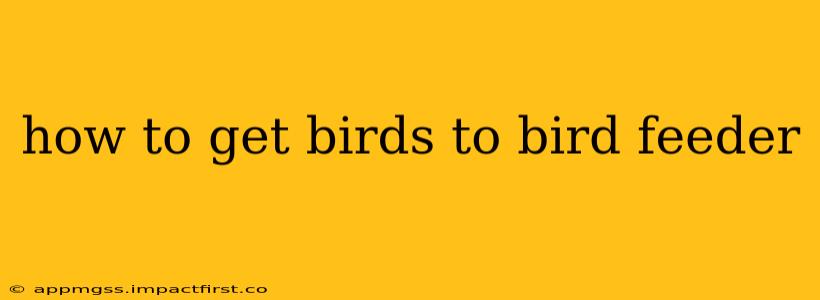Attracting birds to your backyard feeder can be a rewarding experience, bringing vibrant color and lively sounds to your outdoor space. However, simply putting up a feeder isn't always enough. Understanding bird behavior and preferences is key to success. This comprehensive guide will walk you through everything you need to know to become a bird-feeding pro.
What Kind of Bird Feeder Should I Use?
The type of feeder you choose significantly impacts which birds you attract. Different feeders dispense food in various ways, catering to different bird species' feeding habits.
- Tube feeders: These are popular choices, often holding seeds and attracting smaller birds like finches and chickadees. Look for feeders with perches that are spaced to accommodate different bird sizes.
- Hopper feeders: These larger feeders hold substantial amounts of seed and often have multiple feeding ports, attracting a variety of birds.
- Platform feeders: These open feeders are ideal for larger birds like doves and jays, but can also attract squirrels.
- Suet feeders: Suet is a high-energy food source perfect for winter feeding, attracting woodpeckers and nuthatches. Consider mesh feeders to deter squirrels.
What Kind of Birdseed Should I Use?
Offering a variety of birdseed will attract a wider range of species. Some popular options include:
- Black oil sunflower seeds: A favorite amongst many birds due to their high oil content and easy-to-crack shells.
- Nyjer (thistle) seeds: Attracts smaller birds like goldfinches and siskins. Use specialized feeders to prevent seed waste.
- White-striped sunflower seeds: A less expensive alternative to black oil sunflower seeds, still popular with many birds.
- Mixed seeds: While convenient, these often contain fillers birds might ignore.
Where Should I Place My Bird Feeder?
Placement is crucial for attracting birds and deterring predators.
- Location: Place your feeder in a visible location, away from dense vegetation where cats or other predators can hide. Consider proximity to trees or shrubs for birds to safely perch and escape.
- Height: Hanging feeders 3-5 feet from the ground is usually a good starting point. Adjust the height based on your specific birds and potential predators.
- Shelter: Provide some form of overhead cover to protect birds from rain and harsh sunlight.
How Often Should I Clean My Bird Feeder?
Regular cleaning is essential to prevent the spread of disease. Clean your feeder at least once a month, or more frequently during warm, humid weather. Use a mild soap solution and thoroughly rinse before refilling.
What Else Can I Do to Attract Birds?
Beyond feeders and seed, consider these additional steps:
- Provide a water source: Birds need water for drinking and bathing, especially during hot weather. A birdbath or shallow dish of water will greatly enhance your bird-attracting efforts.
- Plant native plants: Native plants provide food sources like berries and seeds, creating a natural habitat that birds find attractive.
- Avoid using pesticides: Chemical pesticides can harm birds and their food sources. Opt for natural pest control methods instead.
What If I Don't See Any Birds at My Feeder?
If you've followed these steps and still aren't attracting birds, consider these factors:
- Competition: Existing bird populations in your area may be impacting the success of your feeder. Try experimenting with different types of seed or feeder placement.
- Predators: Cats, hawks, and other predators can scare birds away. Ensure your feeder is strategically placed to minimize risk.
- Patience: It might take some time for birds to discover your feeder, particularly if you are in a new area. Continue to offer food consistently.
What are some common problems with bird feeders?
- Squirrels raiding the feeder: Employ squirrel-resistant feeders or place baffles below the feeder to deter these furry competitors.
- Ants or other insects infesting the feeder: Regular cleaning is essential to minimize insect problems. Consider using ant traps or baffles.
- Birds not visiting: Try different types of seed, different feeder styles, and varying placement locations.
By understanding bird behavior and preferences, and by implementing these tips, you can significantly increase your chances of attracting a variety of birds to your backyard feeder, providing a welcoming and enjoyable environment for both you and your feathered friends. Remember patience and persistence are key to success!
